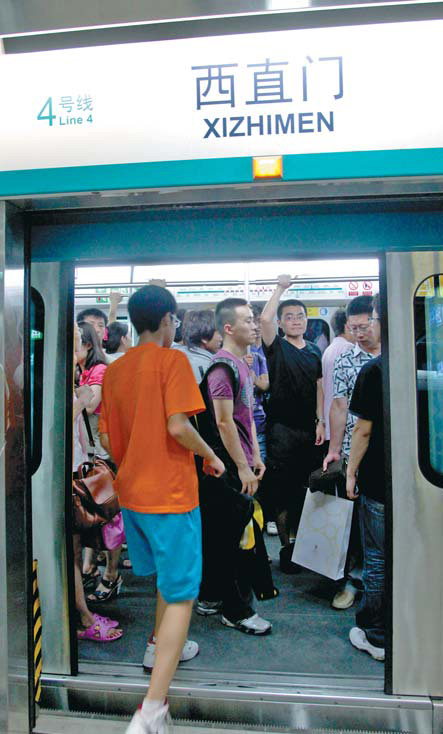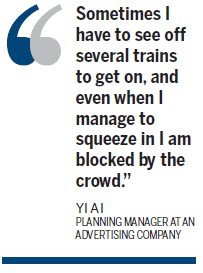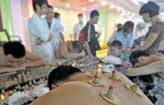Society
Officials urge to ease subway overcrowding
Updated: 2011-07-26 07:45
By Xu Wei (China Daily)
BEIJING - Subway bosses have been urged to prevent overcrowding on trains and in stations, as officials look to step up safety in the wake of several fatal accidents on public transport.
Gou Zhongwen, deputy mayor of Beijing, said the city should be committed to improving the handling of crowds on platforms, escalators and in transfer passageways.
 |
|
A passenger steps onto a crowded metro train on Monday at Xizhimen station. Government officials say they are considering ways to restrict passenger flow on the metro, especially during rush hours. Liu Zhe / for China Daily |
His comments came as the nation reeled from a bullet train collision on Saturday that killed at least 39 people and a bus blaze on Friday that claimed 41 lives.
With the subway network playing an increasingly important role in Beijing's transport development, overcrowding has become a major headache for commuters, who use it to make an estimated 7.27 million journeys every day.
"The only thing we do to disperse the crowd during rush hour is to force passengers to take roundabout ways to transfer to other lines," said a duty manager at Line 5's Huixinxijienankou station who did not want to be identified.
"We close some stairways during rush hour, forcing passengers to take longer ways to other platforms."
A spokesman for Beijing Subway Company refused to answer questions sent by fax on Monday, only saying that it is still researching ways to solve the problem of overcrowding.
So far the subway station has not taken any action to either measure or control passenger flow, the station duty manager said.

Trains on Line 5, made by Changchun Railway Vehicles, have 240 seats and a maximum capacity of 1,820 passengers, meaning nine people per square meter, according to the manufacturer's website.
"Sometimes I have to see off several trains to get on, and even when I manage to squeeze in I am blocked by the crowd," said Yi Ai, a 25-year-old planning manager at a foreign advertising company in Beijing.
Yi said the problem is not as bad as it seems. "The crowd is intimidating but there is always space as long as you try to squeeze in," she said.
The deputy mayor's statement at a safety conference on Sunday has caused heated discussion on Sina Weibo, a major Chinese micro-blog website, with many netizens expressing concern that solving the problem of congestion could affect the efficiency of the metro system.
"I might arrive at my workplace just in time for lunch if there was no passenger overflow," wrote "Duocaidetudou".
Problems created by overcrowding can be traced to 2007, when a train broke down due to overloading and dumped more than 1,000 passengers onto a platform at Dongdan station. It took an hour to get the passengers out of the station.
Beijing plans to build 10 new subway lines in the next five years, 80 percent of which will be in the downtown area.
Meanwhile, the city has been encouraging the use of public transport, including rail transit, to solve the long-standing traffic congestion problems on the city's roads.
An official in the Beijing subway's command center told Beijing Daily that the estimated daily passenger flow on the capital's metro will hit 10 million individual journeys next year, making it the busiest network in the world.
Wang Yan contributed to this story.

Specials

Turning up the heat
Traditional Chinese medicine using moxa, or mugwort herb, is once again becoming fashionable

Ciao, Yao
Yao Ming announced his retirement from basketball, staging an emotional end to a glorious career.

Financial sector short of talent
Lack of skilled professionals in Shanghai inhibiting the city's development as a financial hub